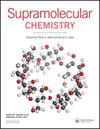Controlling selective formation of [2]- and [3]-pseudorotaxanes by tuning spacer length of guests
IF 2.6
4区 化学
Q3 CHEMISTRY, MULTIDISCIPLINARY
引用次数: 0
Abstract
ABSTRACT Exploration of host–guest complexation between a shape-persistent H-bonded macrocycle and flexible guests may enable construction of new pseudorotaxanes systems. Here, we present the impact of varying the spacer length of four bis(4-phenylpyridinium) guests G1-G4 on production of pseudorotaxanes with a 2D H-bonded macrocycle 1a. The host–guest complexes are probed by 1H NMR, 2D NOESY and UV–vis spectroscopic techniques. [2]- and [3]- pseudorotaxane assemblies are formed specifically using these guests, demonstrating the dependency of accessing [2]- and [3]- pseudorotaxane on the spacer length of these dications. Theoretical calculations reveal the difference in the conformation of the guests between these two binding modes: the one with a 1:1 stoichiometry (spacer length: C4 and C6) show Z-shaped conformation and the other with a 2:1 stoichiometry (spacer length: C8 and C10) take a linear conformation. The findings of the threading modes may help develop new H-bonded macrocycle-based rotaxanes and other related mechanically interlocked molecules. GRAPHICAL ABSTRACT通过调节客体的间隔长度来控制[2]-和[3]-伪环紫杉烷的选择性形成
探索形状持久的h键大环与柔性客体之间的主客体络合作用,可能有助于构建新的假环紫杉烷体系。在这里,我们研究了改变四个双(4-苯基吡啶)客体G1-G4的间隔长度对用2D氢键大环1a生产假环紫杉烷的影响。采用1H NMR, 2D NOESY和UV-vis光谱技术对主客体配合物进行了探测。[2]-和[3]- pseudorotaxane组件是专门使用这些来宾形成的,这表明访问[2]-和[3]- pseudorotaxane依赖于这些指示的间隔长度。理论计算揭示了这两种结合模式之间的宾客构象差异:化学计量比为1:1(间隔长度:C4和C6)的宾客构象为z形,化学计量比为2:1(间隔长度:C8和C10)的宾客构象为线性。研究结果可能有助于开发新的基于h键大环的轮烷和其他相关的机械互锁分子。图形抽象
本文章由计算机程序翻译,如有差异,请以英文原文为准。
求助全文
约1分钟内获得全文
求助全文
来源期刊

Supramolecular Chemistry
化学-化学综合
CiteScore
3.60
自引率
3.00%
发文量
5
审稿时长
2.7 months
期刊介绍:
Supramolecular Chemistry welcomes manuscripts from the fields and sub-disciplines related to supramolecular chemistry and non-covalent interactions. From host-guest chemistry, self-assembly and systems chemistry, through materials chemistry and biochemical systems, we interpret supramolecular chemistry in the broadest possible sense. Interdisciplinary manuscripts are particularly encouraged. Manuscript types include: high priority communications; full papers; reviews, and; Methods papers, techniques tutorials highlighting procedures and technologies that are important to the field. We aim to publish papers in a timely fashion and as soon as a paper has been accepted and typeset it will be published in electronic form on the Latest articles section of the website. The two most important review criteria are that the paper presents high-quality work that fits generally into the broad spectrum of activities in the supramolecular chemistry field. Under normal circumstances, Supramolecular Chemistry does not consider manuscripts that would be more suitable in a highly specialized journal. This includes, but is not limited to, those based mostly or exclusively on topics such as solid state/X-ray structures, computational chemistry, or electrochemistry. .
The two most important review criteria are that the paper presents high-quality work that fits generally into the broad spectrum of activities in the supramolecular chemistry field.
 求助内容:
求助内容: 应助结果提醒方式:
应助结果提醒方式:


